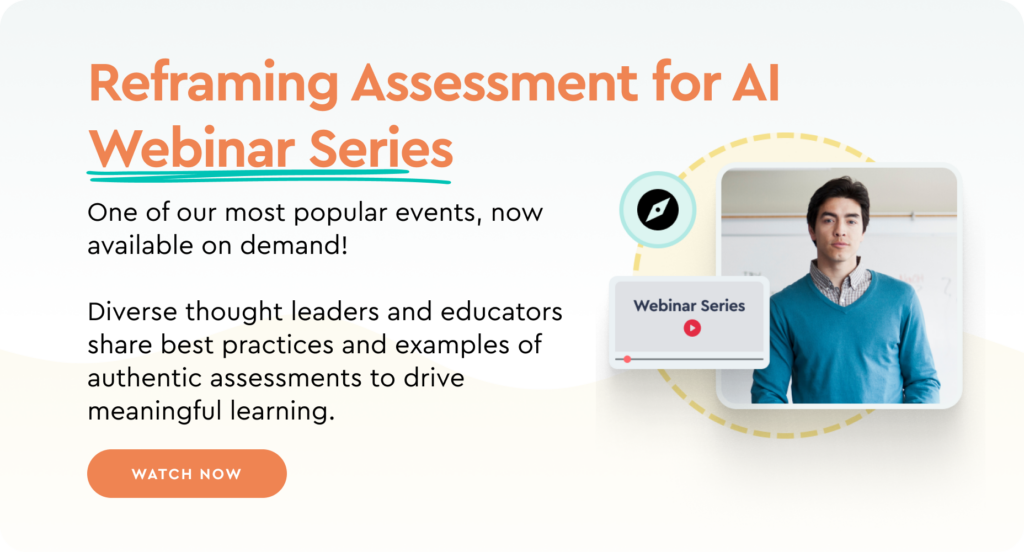The integration of AI into higher education has become a hot topic. AI in education is transforming the way students learn and instructors teach. Some may still consider AI a fad, but most believe it’s here to stay because it offers numerous benefits when used to complement traditional instruction and assessments rather than replace them.
In this blog, we explore the current sentiment around AI in higher education, examples of how AI can complement learning comprehension, some cons to the presence of AI in education, and the solution to help you outsmart AI and deliver authentic assessments that drive lifelong learning.
The Current Sentiment Around AI in Higher Education
A recent survey of college-level educators and GoReact users reveals compelling statistics that provide a glimpse into the current sentiment towards AI in education.
- 67% of educators haven’t yet adjusted assignments due to AI.
- 55% are unsure about allowing students to use AI tools.
- 19% encourage students to use AI tools.
- 16% are considering consequences for students who use AI tools for classwork.
It’s clear that the education sector is at a crossroads when it comes to AI. While some embrace it, many are cautious and uncertain about the extent to which AI should be integrated into the learning process. The overall consensus? AI should complement traditional instruction and assessment, not replace them.

Pros and Cons of AI in Higher Education
It’s essential to weigh the advantages and disadvantages that AI brings to the educational landscape. Here, we’ll explore the pros and cons of AI in education to provide a comprehensive view of its impact.

What are the pros of AI in education?
For both students and staff, there are many ways that using AI can complement and benefit the learning experience. Here are just a few:
- Enhanced Research and Data Gathering: AI equips students with the ability to conduct more efficient and in-depth research, enabling them to gather, analyze, and interpret data effectively.
- Ideation and Context Expansion: AI-powered tools assist students in brainstorming ideas, expanding on existing concepts, and providing a broader context for their assignments, fostering critical thinking and creativity.
- Improvement of Communication Skills: Some AI can facilitate and enhance communication skills by providing feedback and suggestions on their original pieces — helping students engage in meaningful discussions, provide constructive feedback, and collaborate effectively in various educational settings.
What are the cons of AI in education?
And of course, there’s a downside to AI gaining a larger presence in higher education. Here are the top concerns that most educators raise:
- Academic Dishonesty: With easy access to AI tools, students may be tempted to use them for unethical purposes, such as plagiarism or cheating on exams.
- Overreliance on Technology: Excessive dependence on AI may lead to students and educators neglecting essential human skills like critical thinking, creativity, and problem-solving.
- Privacy and Security Concerns: The collection and storage of student data by AI systems raise concerns about privacy and data security. It’s essential to ensure that these systems adhere to strict data protection standards.
A Solution to Outsmart AI: Delivering Authentic Assessments With Video
To address these challenges, educators need a solution that allows them to navigate the challenges of AI while embracing the benefits. Video + feedback tools deliver authentic assessments, allowing students and educators to leverage AI as a complementary tool, not a replacement, in the learning process.
Video allows students to demonstrate not only knowledge but skills that they will need after graduation. Video also produces evidence of learning, and can enable self-reflection, peer and instructor feedback — all vital components of lifelong learning. Video + feedback tools help educators design assessments that foster critical thinking and problem-solving, ensuring students acquire not just information but also the ability to apply it.
The role of AI in higher education is evolving, with educators striving to strike a balance between embracing its potential and preserving traditional instructional values. The key is to harness AI as a complement to, not a replacement for, instruction — and video + feedback software empowers you to do just that.
Ready to learn more?
Access our Ultimate Guide to Authentic Assessment in an AI-Enabled World for insights and practical tips on designing assessments to support learning and prevent cheating in the age of AI.








